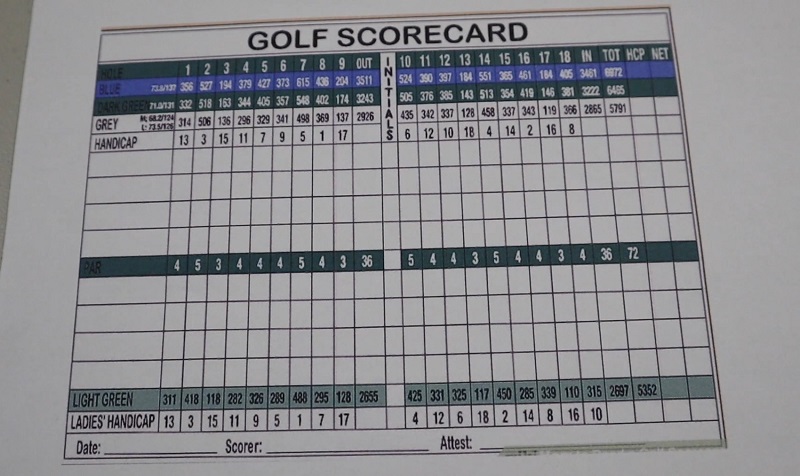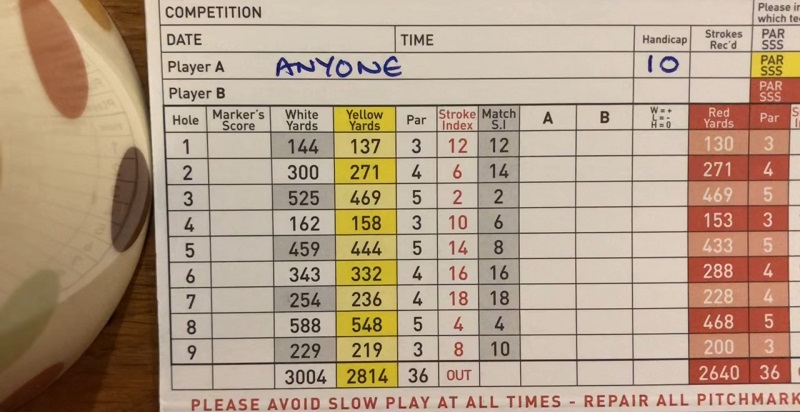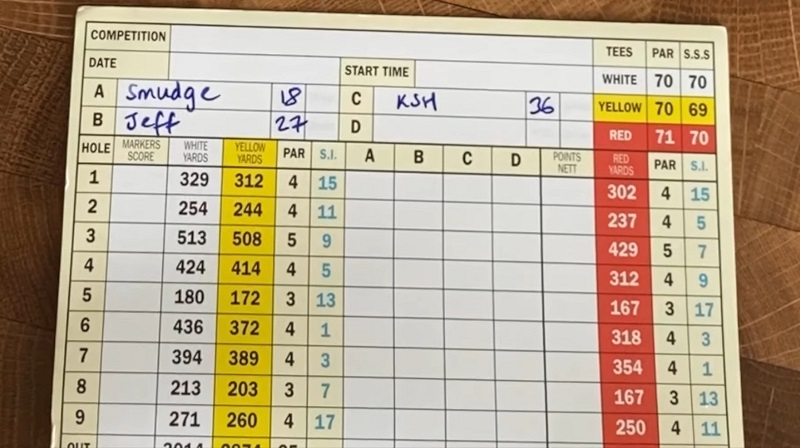Golf is a fantastic game with many nuances and subtleties, one of the most challenging being understanding how to keep score properly. Keeping score can confuse newcomers and experienced golfers alike, who might not understand the significance of each particular stroke or the finer points of scoring in different formats. However, keeping track of your progress on the course is essential for making visible improvements to your game.
In this guide, we’ll discuss all you need to know about how to properly and effectively track your scores in golf. Read on for our comprehensive beginner’s guide into everything you need to know about keeping score in golf!
Why Do You Have To Keep Scores In Golf?
Keeping score in golf is important because it helps you track your progress over time and allows you to compare your performance against others. Keeping a score gives you a way to measure yourself, your improvement, and the success of any changes you’ve made in technique or strategy.
It also provides an accurate record that can be used for handicapping, so you can play against players of different skill levels and still have a chance to compete. Finally, keeping score allows for tracking of individual and team performance in tournaments and other competitions. By having an accurate record of your performance, it’s much easier to identify any weaknesses or areas where you need improvement.
Keeping track of your scores also allows you to set goals and measure progress toward them. By looking back at your scores, you can make sure that you’re on track with your goals and keep yourself motivated to improve. Overall, keeping score in golf is an important part of the game and a valuable tool for tracking progress.
How To Keep Your Score In Golf?

As simple as it may seem, basic scorekeeping in golf can get trickier as the game progresses. Apart from counting each stroke you take, you might also have to keep track of penalty strokes. But don’t let that discourage you! Every time you make a shot, mark it down and tally your score for each hole. When you’ve completed your round, add it all up and you’ll know your total score. Keeping scores accurate is essential in golf, but it also helps with setting new goals for improvement.
In Match Play
For beginners, a simple way to keep score is to mark each hole as “holes up” or “holes down.” The objective is to win more holes than your opponent, rather than keeping track of every detail of the round. For example, if your score on the first hole is 5 and your opponent’s score is 3, your opponent is now “one up” since they are one hole ahead of you. If you are struggling to get the ball into a hole during a particular round, you can choose to concede that hole and move on to the next.
Keep track of the winner of each hole by writing down +1 for the person who won that round or -1 for the person who lost it. If both players take the same number of strokes to complete a hole, mark it as a draw by writing “AS” underneath it. The game ends when one player is leading by more holes than there are remaining to play. For instance, a score of “four and three” means that one player is four holes ahead with only three holes left to play, making it impossible for the other player to win.
As a beginner, focus more on getting the ball into the hole rather than stressing over how many shots it takes to get there. This approach allows you to develop a rhythm and enjoy the game without overanalyzing every shot. As you become more skilled, you can start keeping track of each shot and look for ways to improve your game.
In Stroke Play
To keep track of your score while playing golf, start by obtaining a scorecard and recording your score after each hole. It is essential to keep track of your score and the scores of other players in your group, and it is customary for each player to keep their opponent’s score.
After each round, review your opponent’s scorecard to ensure that they have recorded your score correctly, and sign or initial it. Count every attempt to strike the ball as a stroke, including a whiff, and practice swings that accidentally hit the ball do not count. Each hole has a designated “Par,” which is the average number of strokes needed to complete the hole. Birdie, eagle, and bogey are all terms used to describe the number of strokes below or above par.
Penalties, such as hitting the ball out of bounds or losing a ball, will cost you extra points, so it’s critical to know them. When finished, add up your scores for each hole for a cumulative total. Keep in mind that the player with the least amount of points wins the game. Additionally, after ten rounds, you will have a handicap, which takes your previous scores into account and helps you track your progress.
Stableford System

The Stableford system is a popular method of scoring in golf, where points are awarded to players based on their performance relative to the par of each hole. It is a preferred scoring method among recreational golfers because it eliminates the possibility of negative scores, with a double bogey or worse resulting in zero points. However, the final score still depends on the player’s ability.
When recording a Stableford score on a scorecard, players typically use two lines. This makes it easy to keep track of the scores and review them later. The first line represents the stroke play score, which is the number of strokes taken to complete a hole. The second line indicates the Stableford points earned on that hole. After the 9th hole, the Stableford scores are added up, and at the end of the 18th hole, two points are added from each half of the 9 holes to arrive at the total Stableford score.
Tips For Keeping Accurate Golf Scores
Know the score of each hole before you begin: Before teeing off on a new hole, make sure to know what the par for that hole is and how many strokes it will take to reach the green in regulation. This information can help remind you during the round of your goal for each shot.
Count every stroke: It is important to count every shot you take during the round. This will help ensure that you are honest with your score and not overlook any shots that may have been taken.
Double-check your scores at the end of each hole: Once you have finished a hole, go back and double-check the score to make sure you have counted all of your shots correctly. It is easy to overlook a shot or two during the game’s heat, which can drastically affect your end score.
Use a scorecard: A scorecard is an invaluable tool that can help you keep track of each hole’s score and any extra strokes that are taken. Make sure to properly fill out the scorecard and double-check it at the end of every round to ensure accuracy.
Know the rules: Knowing the rules of golf can also help keep accurate scores. For example, if a ball goes out of bounds, there is usually an additional penalty stroke must be accounted for. Knowing the rules helps you to stay aware of all possible situations that could occur during a round.
Keep track of putts: It is easy to forget the number of putts taken on a hole, especially if you are playing at a fast pace. Always keep track of how many putts are taken on each hole, as this can make a huge difference in your end score.
Take a break: If you feel like your concentration is waning, take a few moments to step back and reassess your scorecard or the situation at hand. Taking some time away from the game can help you stay focused and ensure you are honest with your scoring.
Terms in Golf Scorekeeping
Stroke: This term refers to a single shot taken during the game of golf. Each stroke allows you to move your ball closer to the hole and can vary in difficulty depending on the type of shot and course layout.
Par: This refers to the number of strokes a skilled golfer takes to complete each hole in the course. The par number is sometimes represented by an “X” on the scorecard, and it is up to the player to use no more than this number of strokes per hole.
Bogey: When a golfer takes one more stroke than par for a hole, it is called a bogey. Scorecards will show how many bogeys each golfer has taken on the course and for each hole.
Birdie: When a golfer takes one fewer strokes than the par number for a given hole, it is referred to as a birdie. This is considered to be an impressive feat and can help to reduce your overall score for the round greatly.
Eagle: When a golfer takes two fewer strokes than par on a hole, it is referred to as an eagle. This is even more impressive than a birdie, but quite difficult to achieve.
Albatross: This is the highest score achievable in a single hole, and requires three strokes fewer than par. It is considered to be extremely rare and only achieved by the most skilled golfers.
Double Bogey: When a player takes two more strokes than the par number for a given hole, it is referred to as a double bogey. This can be a frustrating score and is often seen as an indicator of a poor round of golf.
Hole In One: This is when a golfer sinks his ball into the hole in one shot. It is incredibly difficult to do and is seen as an impressive feat. For most players, this may only happen once or twice in their lifetime.
Scorecard: This refers to the document that tracks each golfer’s progress for the entire course. It will include details such as strokes taken, total score, birdies, bogeys, and other information.
Net Score: This is the final score of a round of golf, including all strokes taken by each player and any bonuses or penalties, minus the player’s handicap. It is used to compare players on an even playing field and can be used for handicaps in tournaments.
Final Thoughts
Taking up golf can provide any aspiring player with a healthy pastime that both exercises their body and mind. With this beginner guide, keeping score in golf should no longer be viewed as an intimidating challenge. Moreover, understanding golf scorekeeping even provides an extra layer of enjoyment when out on the course. Maybe the most beneficial aspect of having a keen eye for scoring golf is being able to track progress over time as players improve their handicap.
Like any new skill, it takes practice to become proficient with scorekeeping. The important thing is to start small, have fun, and continue learning more about the sport along the way. Breathe in the fresh air and soak up some tranquility in return for bettering your golf skills; now that’s real reward!
Once you start getting good at tracking your scores from round to round it will become second nature – giving you plenty more confidence on the next swing! After all, keeping score in golf offers a unique opportunity to stay organized, motivated and connected with how each game goes regardless of who wins or loses.
References: https://www.wikihow.com/Keep-Score-in-Golf


